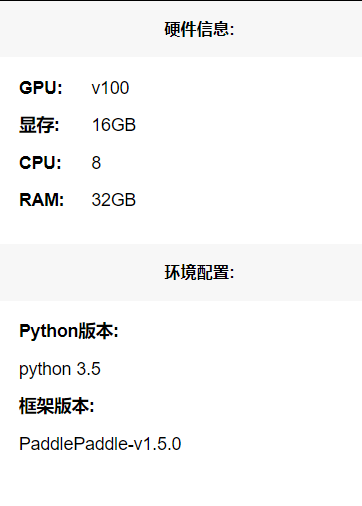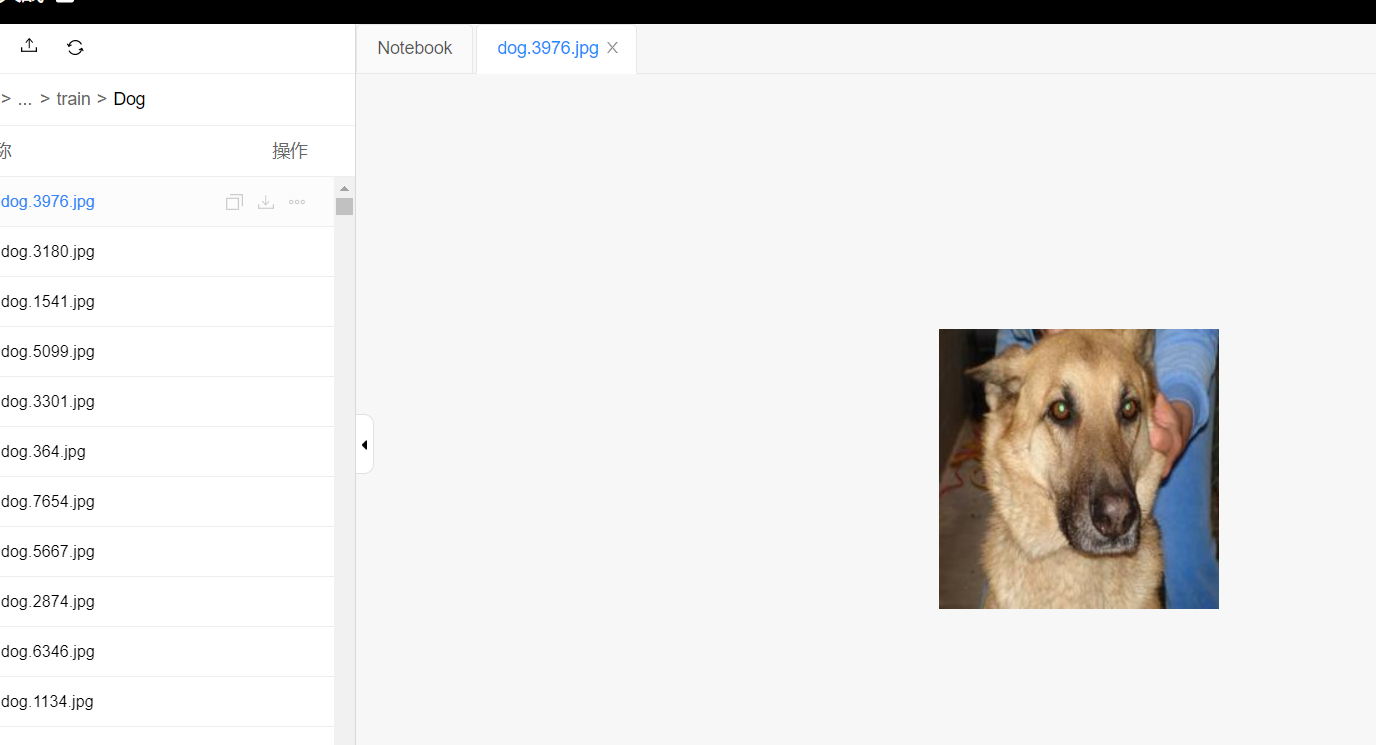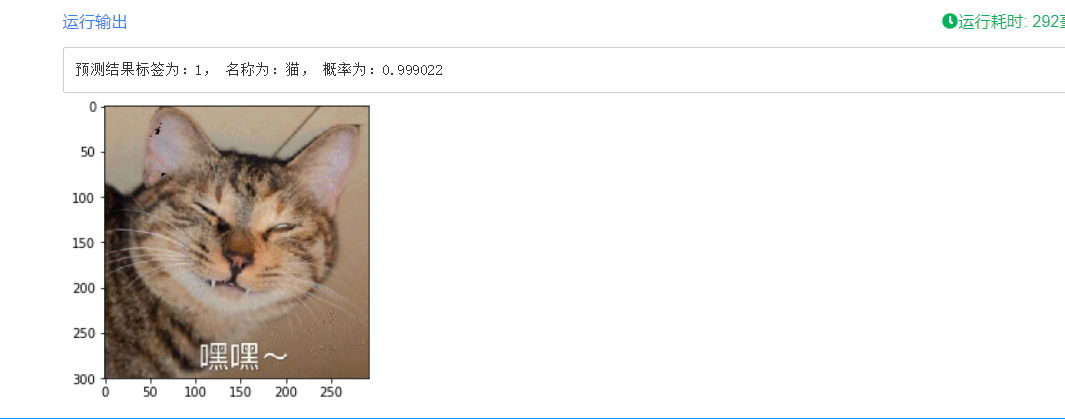paddlepaddle实现猫狗分类
声明:这是我的个人学习笔记,大佬可以点评,指导,不喜勿喷。实现过程参考自夜雨飘零的博客以及实现代码。框架是百度开源的框架paddlepaddle。
1.预备工作
这是我上学期一直没有去填补的坑,之前想通过传统机器学习方法来实现,不过没做完。暑假难得回一次家,所以我想该把我没做完的坑填完吧。
代码到现在为止已经写完了,不过还是存在坑的,比如哈士奇它会识别成猫。。。。
依赖的平台是百度的AIStudio,因为本地电脑960M的显卡受不了呀。
配置环境如下图所示。

1.1 数据集准备
我采用的是猫狗大战的数据集,从官方下载而来。
https://www.microsoft.com/en-us/download/confirmation.aspx?id=54765
下载完成后,把它解压到合适的位置。文件夹的结构是:
AiStuido上的解压命令是
!unzip -qo /home/aistudio/data/data10141/origin.zip -d /home/aistudio/data/datas
PetImages
┣ Cat
┗ Dog
1.2 数据预处理
1.2.1 删除无用的图片
因为猫狗分类中可能会出现很多因素影响分类效果,所以在进行训练之前,我们需要将图片进行一定的预处理。以提高训练的准确精度。
大概思路:
如果图片格式不是JPEG同时也不是PNG就删除图片
删除灰度图
如果图片大小为0(因为猫狗大战的数据集里面存在大小为0B的图片)
具体实现代码如下
# 删除不是JPEG或者PNG格式的图片
def delete_error_image(father_path):
print(father_path)
# 获取父级目录的所有文件以及文件夹
try:
image_dirs = os.listdir(father_path)
for image_dir in image_dirs:
image_dir = os.path.join(father_path, image_dir)
# 如果是文件夹就继续获取文件夹中的图片
if os.path.isdir(image_dir):
images = os.listdir(image_dir)
for image in images:
image = os.path.join(image_dir, image)
try:
# 获取图片的类型
image_type = imghdr.what(image)
# 如果图片格式不是JPEG同时也不是PNG就删除图片
if image_type is not 'jpeg' and image_type is not 'png':
os.remove(image)
print('已删除:%s' % image)
continue
# 删除灰度图
img = np.array(Image.open(image))
if len(img.shape) is 2:
os.remove(image)
print('已删除:%s' % image)
# 如果图片大小为0(因为猫狗大战的数据集里面存在大小为0B的图片)
if img.size == (0,0):
os.remove(image)
print('已删除:%s' % image)
except:
os.remove(image)
print('已删除:%s' % image)
except:
pass
主要利用的框架库是numpy,PIL,os库。
运行效果如下图所示:
因为,当前数据集是我已经处理过的,所以说不存在以上情况的图片。

1.2.2 reshape
通过查看我们知道所有图片的尺寸是不一样的,这就需要我们通过代码对于图片尺寸进行一定的调整。此处我统一调整成了224,224。(前提是之前要成功删除了一些无用的图片,否则在此步骤处理图片的时候会报错。)
# 预处理图片
def load_image(file,f):
img = Image.open(file)
# 统一图像大小
img = img.resize((224, 224), Image.ANTIALIAS)
# 输出处理日志,便于排错。
f.write("the file path is " + str(file) + ",the size is " + str(img.size) + "\n")
img = img.convert("RGB")
img.save(file)
1.2.3 数据集划分
读取前8000张代码进行训练,(增大数据集,提高模型的准确性!)
def __load_data_set():
srcDog = os.listdir(dog_origin_path)
# 读取前8000张图片复制到训练集中
fnames = ['{}.jpg'.format(i) for i in range(0,8000)]
i = 0
for fname in fnames:
src = os.path.join(dog_origin_path, srcDog[i])
dst = os.path.join(dog_train_path, "dog." + fname)
shutil.copyfile(src, dst)
i+=1
srcCat = os.listdir(cat_origin_path)
j = 0
for fname in fnames:
src = os.path.join(cat_origin_path, srcCat[j])
dst = os.path.join(cat_train_path, "cat." + fname)
shutil.copyfile(src, dst)
j+=1
print('total training cat images:',len(os.listdir(cat_train_path)))
print('total training dog images:',len(os.listdir(dog_train_path)))
输出结果

已经生成了。

1.2.4 创建数据列表
#创建数据列表
import json
import os
def create_data_list(data_root_path):
with open(data_root_path + "test.list", 'w') as f:
pass
with open(data_root_path + "train.list", 'w') as f:
pass
# 所有类别的信息
class_detail = []
# 获取所有类别
class_dirs = os.listdir(data_root_path)
# 类别标签
class_label = 0
# 获取总类别的名称
father_paths = data_root_path.split('/')
while True:
if father_paths[len(father_paths) - 1] == '':
del father_paths[len(father_paths) - 1]
else:
break
father_path = father_paths[len(father_paths) - 1]
all_class_images = 0
other_file = 0
# 读取每个类别
for class_dir in class_dirs:
if class_dir == 'test.list' or class_dir == "train.list" or class_dir == 'readme.json':
other_file += 1
continue
print('正在读取类别:%s' % class_dir)
# 每个类别的信息
class_detail_list = {}
test_sum = 0
trainer_sum = 0
# 统计每个类别有多少张图片
class_sum = 0
# 获取类别路径
path = data_root_path + "/" + class_dir
# 获取所有图片
img_paths = os.listdir(path)
for img_path in img_paths:
# 每张图片的路径
name_path = class_dir + '/' + img_path
# 如果不存在这个文件夹,就创建
if not os.path.exists(data_root_path):
os.makedirs(data_root_path)
# 每10张图片取一个做测试数据
if class_sum % 10 == 0:
test_sum += 1
with open(data_root_path + "test.list", 'a') as f:
f.write(name_path + "\t%d" % class_label + "\n")
else:
trainer_sum += 1
with open(data_root_path + "train.list", 'a') as f:
f.write(name_path + "\t%d" % class_label + "\n")
class_sum += 1
all_class_images += 1
# 说明的json文件的class_detail数据
class_detail_list['class_name'] = class_dir
class_detail_list['class_label'] = class_label
class_detail_list['class_test_images'] = test_sum
class_detail_list['class_trainer_images'] = trainer_sum
class_detail.append(class_detail_list)
class_label += 1
# 获取类别数量
all_class_sum = len(class_dirs) - other_file
# 说明的json文件信息
readjson = {}
readjson['all_class_name'] = father_path
readjson['all_class_sum'] = all_class_sum
readjson['all_class_images'] = all_class_images
readjson['class_detail'] = class_detail
jsons = json.dumps(readjson, sort_keys=True, indent=4, separators=(',', ': '))
with open(data_root_path + "readme.json", 'w') as f:
f.write(jsons)
print('图像列表已生成')
输出结果:

2.训练
2.1 模型
我们针对移动端以及嵌入式视觉的应用提出了一类有效的模型叫MobileNets。MobileNets基于一种流线型结构使用深度可分离卷积来构造轻型权重深度神经网络。我们介绍两个能够有效权衡延迟和准确率的简单的全局超参数。这些超参数允许模型构造器能够根据特定问题选择合适大小的模型。我们在资源和准确率的权衡方面做了大量的实验并且相较于其他在ImageNet分类任务上著名的模型有很好的表现。然后,我们演示了MobileNets在广泛应用上的有效性,使用实例包含目标检测、细粒度分类、人脸属性以及大规模地理位置信息。\
实现代码是现成的,直接在百度官方网站上获取的。
2.2 定义训练
以下代码是定义训练的代码,基本上代码都是类似的,完成一个训练,都需要定义这些东西。
# 定义输入层(此处我们没有处理灰度图,所以还是三通道)
image = fluid.layers.data(name='image', shape=[3, crop_size, crop_size], dtype='float32')
label = fluid.layers.data(name='label', shape=[1], dtype='int64')
# 获取分类器(猫狗属于二分类)
model = net(image, 2)
# 获取损失函数和准确率函数
cost = fluid.layers.cross_entropy(input=model, label=label)
avg_cost = fluid.layers.mean(cost)
acc = fluid.layers.accuracy(input=model, label=label)
# 获取训练和测试程序
test_program = fluid.default_main_program().clone(for_test=True)
# 定义优化方法(设置学习率,和规则化函数,预防过拟合事件的发生)
optimizer = fluid.optimizer.AdamOptimizer(learning_rate=1e-3,
regularization=fluid.regularizer.L2DecayRegularizer(1e-4))
opts = optimizer.minimize(avg_cost)
# 获取自定义数据
train_reader = paddle.batch(train_reader('data/datas/train/train.list', crop_size, resize_size), batch_size=64)
test_reader = paddle.batch(test_reader('data/datas/train/test.list', crop_size), batch_size=64)
# 定义一个使用GPU的执行器(处理图像,CPU太慢(本地笔记本亲测))
place = fluid.CUDAPlace(0)
# place = fluid.CPUPlace()
exe = fluid.Executor(place)
# 进行参数初始化
exe.run(fluid.default_startup_program())
# 定义输入数据维度
feeder = fluid.DataFeeder(place=place, feed_list=[image, label])
2.3 训练
代码
# 训练10次
for pass_id in range(20):
# 进行训练
#
for batch_id, data in enumerate(train_reader()):
train_cost, train_acc = exe.run(program=fluid.default_main_program(),
feed=feeder.feed(data),
fetch_list=[avg_cost, acc])
# 每100个batch打印一次信息
if batch_id % 100 == 0:
print('Pass:%d, Batch:%d, Cost:%0.5f, Accuracy:%0.5f' %
(pass_id, batch_id, train_cost[0], train_acc[0]))
# 进行测试
test_accs = []
test_costs = []
for batch_id, data in enumerate(test_reader()):
test_cost, test_acc = exe.run(program=test_program,
feed=feeder.feed(data),
fetch_list=[avg_cost, acc])
test_accs.append(test_acc[0])
test_costs.append(test_cost[0])
# 求测试结果的平均值
test_cost = (sum(test_costs) / len(test_costs))
test_acc = (sum(test_accs) / len(test_accs))
print('Test:%d, Cost:%0.5f, Accuracy:%0.5f' % (pass_id, test_cost, test_acc))
# 保存预测模型
save_path = 'infer_model/'
# 删除旧的模型文件
shutil.rmtree(save_path, ignore_errors=True)
# 创建保持模型文件目录
os.makedirs(save_path)
# 保存预测模型
fluid.io.save_inference_model(save_path, feeded_var_names=[image.name], target_vars=[model], executor=exe)
输出结果
Pass:0, Batch:0, Cost:0.67030, Accuracy:0.59375
Pass:0, Batch:100, Cost:0.73609, Accuracy:0.62500
Pass:0, Batch:200, Cost:0.65755, Accuracy:0.62500
Test:0, Cost:0.69298, Accuracy:0.61500
Pass:1, Batch:0, Cost:0.70980, Accuracy:0.56250
Pass:1, Batch:100, Cost:0.67554, Accuracy:0.54688
Pass:1, Batch:200, Cost:0.64920, Accuracy:0.56250
Test:1, Cost:0.69018, Accuracy:0.60250
Pass:2, Batch:0, Cost:0.51662, Accuracy:0.79688
Pass:2, Batch:100, Cost:0.62268, Accuracy:0.60938
Pass:2, Batch:200, Cost:0.58238, Accuracy:0.68750
Test:2, Cost:0.61693, Accuracy:0.67188
Pass:3, Batch:0, Cost:0.61814, Accuracy:0.65625
Pass:3, Batch:100, Cost:0.52823, Accuracy:0.76562
Pass:3, Batch:200, Cost:0.50346, Accuracy:0.75000
Test:3, Cost:0.56010, Accuracy:0.69437
Pass:4, Batch:0, Cost:0.51497, Accuracy:0.70312
Pass:4, Batch:100, Cost:0.54908, Accuracy:0.75000
Pass:4, Batch:200, Cost:0.44495, Accuracy:0.82812
Test:4, Cost:0.51263, Accuracy:0.73750
Pass:5, Batch:0, Cost:0.53596, Accuracy:0.76562
Pass:5, Batch:100, Cost:0.57464, Accuracy:0.75000
Pass:5, Batch:200, Cost:0.67699, Accuracy:0.65625
Test:5, Cost:0.53518, Accuracy:0.74000
Pass:6, Batch:0, Cost:0.46548, Accuracy:0.79688
Pass:6, Batch:100, Cost:0.54030, Accuracy:0.70312
Pass:6, Batch:200, Cost:0.48817, Accuracy:0.78125
Test:6, Cost:0.48508, Accuracy:0.77312
Pass:7, Batch:0, Cost:0.41523, Accuracy:0.84375
Pass:7, Batch:100, Cost:0.47442, Accuracy:0.73438
Pass:7, Batch:200, Cost:0.45649, Accuracy:0.76562
Test:7, Cost:0.44587, Accuracy:0.78375
Pass:8, Batch:0, Cost:0.42541, Accuracy:0.81250
Pass:8, Batch:100, Cost:0.38169, Accuracy:0.81250
Pass:8, Batch:200, Cost:0.54646, Accuracy:0.71875
Test:8, Cost:0.54019, Accuracy:0.74187
Pass:9, Batch:0, Cost:0.41468, Accuracy:0.82812
Pass:9, Batch:100, Cost:0.50506, Accuracy:0.78125
Pass:9, Batch:200, Cost:0.26215, Accuracy:0.93750
Test:9, Cost:0.44446, Accuracy:0.78875
Pass:10, Batch:0, Cost:0.45576, Accuracy:0.76562
Pass:10, Batch:100, Cost:0.35473, Accuracy:0.79688
Pass:10, Batch:200, Cost:0.45957, Accuracy:0.73438
Test:10, Cost:0.44609, Accuracy:0.79812
Pass:11, Batch:0, Cost:0.43150, Accuracy:0.76562
Pass:11, Batch:100, Cost:0.48615, Accuracy:0.79688
Pass:11, Batch:200, Cost:0.25434, Accuracy:0.87500
Test:11, Cost:0.40623, Accuracy:0.82125
Pass:12, Batch:0, Cost:0.31509, Accuracy:0.89062
Pass:12, Batch:100, Cost:0.35438, Accuracy:0.90625
Pass:12, Batch:200, Cost:0.44042, Accuracy:0.82812
Test:12, Cost:0.38933, Accuracy:0.82688
Pass:13, Batch:0, Cost:0.35025, Accuracy:0.84375
Pass:13, Batch:100, Cost:0.39380, Accuracy:0.82812
Pass:13, Batch:200, Cost:0.29557, Accuracy:0.85938
Test:13, Cost:0.40181, Accuracy:0.83000
Pass:14, Batch:0, Cost:0.22922, Accuracy:0.90625
Pass:14, Batch:100, Cost:0.49781, Accuracy:0.84375
Pass:14, Batch:200, Cost:0.23470, Accuracy:0.85938
Test:14, Cost:0.44674, Accuracy:0.81375
Pass:15, Batch:0, Cost:0.32143, Accuracy:0.85938
Pass:15, Batch:100, Cost:0.31085, Accuracy:0.87500
Pass:15, Batch:200, Cost:0.36961, Accuracy:0.82812
Test:15, Cost:0.41548, Accuracy:0.82812
Pass:16, Batch:0, Cost:0.24269, Accuracy:0.90625
Pass:16, Batch:100, Cost:0.29280, Accuracy:0.82812
Pass:16, Batch:200, Cost:0.19174, Accuracy:0.92188
Test:16, Cost:0.32385, Accuracy:0.86375
Pass:17, Batch:0, Cost:0.28380, Accuracy:0.85938
Pass:17, Batch:100, Cost:0.30588, Accuracy:0.81250
Pass:17, Batch:200, Cost:0.32704, Accuracy:0.85938
Test:17, Cost:0.31492, Accuracy:0.86000
Pass:18, Batch:0, Cost:0.29551, Accuracy:0.85938
Pass:18, Batch:100, Cost:0.18694, Accuracy:0.90625
Pass:18, Batch:200, Cost:0.25631, Accuracy:0.85938
Test:18, Cost:0.29839, Accuracy:0.87125
Pass:19, Batch:0, Cost:0.16484, Accuracy:0.95312
Pass:19, Batch:100, Cost:0.11558, Accuracy:0.96875
Pass:19, Batch:200, Cost:0.17472, Accuracy:0.90625
Test:19, Cost:0.25351, Accuracy:0.88813
模型训练之后最终的acc是0.88813。整体还是不错的。
3.预测
这里我准备了1只猫,1只狗来进行测试(不要用哈士奇,,效果不行,这个坑后面解决)。
预测代码如下
import paddle.fluid as fluid
from PIL import Image
import numpy as np
# 创建执行器
place = fluid.CUDAPlace(0)
exe = fluid.Executor(place)
exe.run(fluid.default_startup_program())
infer_image = 'work/train/test2.jpg'
# 保存预测模型路径
save_path = 'infer_model/'
# 从模型中获取预测程序、输入数据名称列表、分类器
[infer_program, feeded_var_names, target_var] = fluid.io.load_inference_model(dirname=save_path, executor=exe)
# 预处理图片
def load_image(file):
img = Image.open(file)
# 统一图像大小
img = img.resize((224, 224), Image.ANTIALIAS)
# 转换成numpy值
img = np.array(img).astype(np.float32)
# 转换成CHW
img = img.transpose((2, 0, 1))
# 转换成BGR
img = img[(2, 1, 0), :, :] / 255.0
img = np.expand_dims(img, axis=0)
return img
# 获取图片数据
img = load_image(infer_image)
# 执行预测
result = exe.run(program=infer_program,
feed={feeded_var_names[0]: img},
fetch_list=target_var)
# 显示图片并输出结果最大的label
lab = np.argsort(result)[0][0][-1]
names = ['猫', '狗']
print('预测结果标签为:%d, 名称为:%s, 概率为:%f' % (lab, names[lab], result[0][0][lab]))
infer_image_show = Image.open(infer_image)
infer_image_show.show()
测试图片

结果:


结果

4.参考文献
https://blog.csdn.net/qq_33200967/article/details/87895105 《PaddlePaddle从入门到炼丹》十一——自定义图像数据集识别
https://github.com/yeyupiaoling/LearnPaddle2/tree/master/note11 github地址
https://ai.baidu.com/docs#/AIStudio_Project_Unit/top 百度平台介绍
paddlepaddle实现猫狗分类的更多相关文章
- 人工智能——CNN卷积神经网络项目之猫狗分类
首先先导入所需要的库 import sys from matplotlib import pyplot from tensorflow.keras.utils import to_categorica ...
- 用tensorflow迁移学习猫狗分类
笔者这几天在跟着莫烦学习TensorFlow,正好到迁移学习(至于什么是迁移学习,看这篇),莫烦老师做的是预测猫和老虎尺寸大小的学习.作为一个有为的学生,笔者当然不能再预测猫啊狗啊的大小啦,正好之前正 ...
- 猫狗分类--Tensorflow实现
贴一张自己画的思维导图 数据集准备 kaggle猫狗大战数据集(训练),微软的不需要FQ 12500张cat 12500张dog 生成图片路径和标签的List step1:获取D:/Study/Py ...
- 1.keras实现-->自己训练卷积模型实现猫狗二分类(CNN)
原数据集:包含 25000张猫狗图像,两个类别各有12500 新数据集:猫.狗 (照片大小不一样) 训练集:各1000个样本 验证集:各500个样本 测试集:各500个样本 1= 狗,0= 猫 # 将 ...
- 使用pytorch完成kaggle猫狗图像识别
kaggle是一个为开发商和数据科学家提供举办机器学习竞赛.托管数据库.编写和分享代码的平台,在这上面有非常多的好项目.好资源可供机器学习.深度学习爱好者学习之用.碰巧最近入门了一门非常的深度学习框架 ...
- Kaggle系列1:手把手教你用tensorflow建立卷积神经网络实现猫狗图像分类
去年研一的时候想做kaggle上的一道题目:猫狗分类,但是苦于对卷积神经网络一直没有很好的认识,现在把这篇文章的内容补上去.(部分代码参考网上的,我改变了卷积神经网络的网络结构,其实主要部分我加了一层 ...
- pytorch实现kaggle猫狗识别
参考:https://blog.csdn.net/weixin_37813036/article/details/90718310 kaggle是一个为开发商和数据科学家提供举办机器学习竞赛.托管数据 ...
- keras猫狗图像识别
这里,我们介绍的是一个猫狗图像识别的一个任务.数据可以从kaggle网站上下载.其中包含了25000张毛和狗的图像(每个类别各12500张).在小样本中进行尝试 我们下面先尝试在一个小数据上进行训练, ...
- 猫狗识别-CNN与VGG实现
本次项目首先使用CNN卷积神经网络模型进行训练,最终训练效果不太理想,出现了过拟合的情况.准确率达到0.72,loss达到0.54.使用预训练的VGG模型后,在测试集上准确率达到0.91,取得了不错的 ...
随机推荐
- python中的set集合和深浅拷贝
一.基础数据类型的补充 1.str中的join算法,将列表转换成字符串,并用'_'(或其他) li=['李嘉诚','马化腾','刘嘉玲','黄海峰',] s='_'.join(li) print(s) ...
- 深入理解ES6 - var-let-const
知识点 var 声明变量: 1.存在变量提升,实际上var无论在哪里声明,都会被当做当前的作用域顶部声明变量. 2.可以重复声明,后声明的变量会覆盖前声明的变量. let 声明变量: 1.不存在变量提 ...
- SpringCloud Sleuth入门介绍
案例代码:https://github.com/q279583842q/springcloud-e-book 一.Sleuth介绍 为什么要使用微服务跟踪?它解决了什么问题? 1.微服务的现状? ...
- Spring Boot 教程
Spring Boot 系列教程: Spring Boot:快速入门教程 Spring Boot:整合Swagger文档 Spring Boot:整合MyBatis框架 Spring Boot:实现M ...
- 每周分享五个 PyCharm 使用技巧(五)
文章首发于 微信公众号:Python编程时光 大家好,这是本系列 PyCharm 的高效使用技巧的第五篇.按照惯例,本次还是分享 5 个. 本系列前四篇如下,若还没看的,你可以点击查阅 21. 随处折 ...
- C++标准库(体系结构与内核分析)(侯捷第一讲)
一.C++标准库介绍 C++标准库:C++ Standard Library C++标准库与STL有什么关系: STL:Standard Template Library STL包含6大部件,基本占标 ...
- 系统学习 Java IO (十五)----字符读写 Reader/Writer 其他子类
目录:系统学习 Java IO---- 目录,概览 跟踪行号的缓冲字符输入流 LineNumberReader LineNumberReader 类是一个 BufferedReader ,用于跟踪读取 ...
- MethodInterceptor-方法拦截器
MethodInterceptor 方法拦截器,也就是aop拦截方法 1.使用示例 public interface MethodInterceptor extends Interceptor { O ...
- Win32小游戏--蜘蛛纸牌
前一段时间完成了蜘蛛纸牌的仿写,现将过程和思路记录下来 首先,为了符合复用性,在win32的基本框架中,把可变的部分用c++封装起来成为一系列虚函数,这样如果再继续写游戏的话,只需要继承这个类就可以了 ...
- 常用的方法论-5W2H
